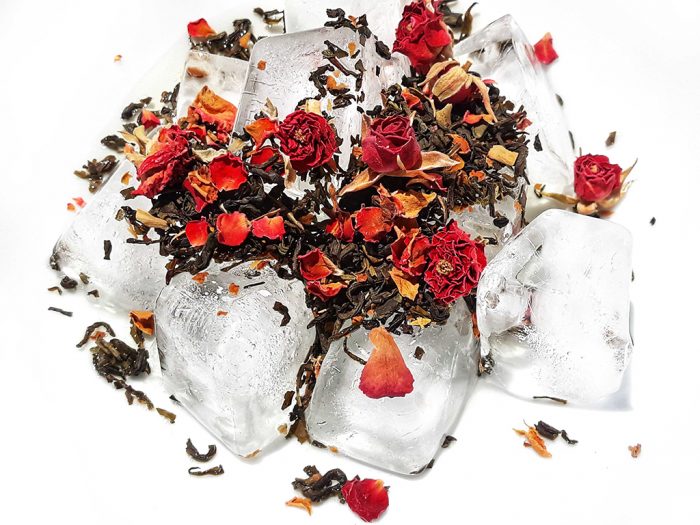The Kouri in Kouridashi means ice.
The dashi part mean extracted liquids, often as a reference to broth.
The simple method is to place high quality tea leaves under or over ice and let them melt. The result is a less bitter tea with more flavor profiles, not to mention it is just pretty. Who wouldn’t want to enjoy pretty and delicious ice tea?
If you’re like me, and want to just try something new quickly, then come back to the why and how…go ahead and get yourself a bowl. Then add some ice and about two spoons of the best quality tea you have. Green tea or white tea works best. In the image shown at the top, I used some green tea mixed with fragrant dried rose buds and petals from my garden. I let it melt for about an hour before using a sieve and pouring over ice. The tea had a lovely delicate flavor, but intense. No bitterness at all. Also my room smelled heavenly all morning.
Of course that’s the fast and easy way. If we want to appreciate and properly honor the Japanese art of Kouridashi, we should not only prepare it in a traditional way, but also understand the reasoning behind the process.
So, for those who want to know why this is maybe the best way to brew tea—beyond being environmentally friendly (tea bags are not recommended, also they contain microplastics), and nearly Zero Waste (ice, tea leaves, done)—Kouridashi brings out the umami flavor in the tea.
Umami is also known as the “fifth flavor.” Most of us already know the other four: sweet, salty, sour, and bitter. Umami is similar to a savory, mellow taste and complements any of the other flavors, adding a depth to whatever you’re enjoying. Brewing tea leaves with hot water often brings out the bitterness of the leaves. By adding the ice to the process, it brings out the sweetest and most savory flavors the leaves and less of the astringent or bitter taste in the tea.
Many traditionalists will use a kyusu (or kyuusu), a covered side-handled teapot to make Kouridashi tea. This is also used widely to brew green tea. Because of the shape of the covered pot and clay base, the ice is able to melt slower, producing a deeper flavor.
I’ve tried both methods—bowl or closed clay teapot. And I’ve tried placing the ice under or over the leaves. All work nicely. I prefer having the open bowl so I can watch it melt and also enjoy the fragrance in anticipation of the flavor. I’ve also used this method with matcha tea, which is basically green tea ground into a powder.
Slowing down to enjoy the art of allowing the delicate tea flavor to develop at its own pace is a meditation in its own.
Here are a few lovely quotes about tea to enjoy while your ice melts:
“Drink your tea slowly and reverently, as if it is the axis on which the world earth revolves—slowly, evenly, without rushing toward the future.” ~ Thich Nhat Hanh
“Each cup of tea represents an imaginary voyage.” ~ Catherine Douzel
“Looking deeply into your tea, you see that you are drinking fragrant plants that are the gift of Mother Earth. You see the labor of the tea pickers; you see the luscious tea fields and plantations in Sri Lanka, China, and Vietnam. You know that you are drinking a cloud; you are drinking the rain. The tea contains the whole universe.” ~ Thich Nhat Hanh
“Do not gulp the tea but sip it slowly allowing its fragrance to fill your mouth. There is no need to have any special attitude while drinking except one of thankfulness.” ~ Pojong Sunim
“In my own hands I hold a bowl of tea; I see all of nature represented in its green color. Closing my eyes, I find green mountains and pure water within my own heart. Silently sitting alone and drinking tea, I feel these become a part of me.” ~ Sen Soshitsu
“In Japan, I took part in a tea ceremony. You go into a small room, tea is served, and that’s it really, except that everything is done with so much ritual and ceremony that a banal daily event is transformed into a moment of communion with the universe.” ~ Okakura Kakuzo
~











Read 2 comments and reply